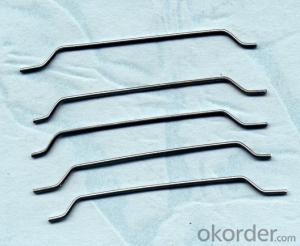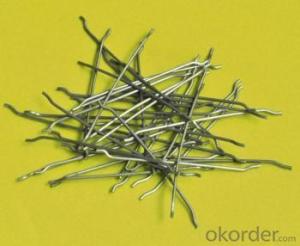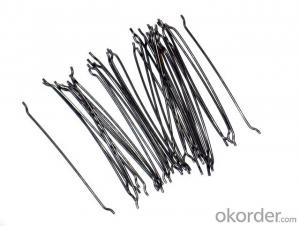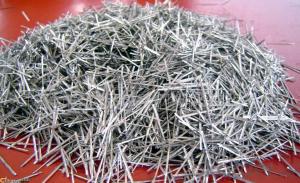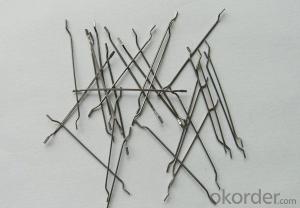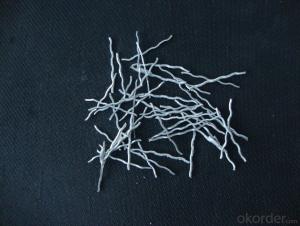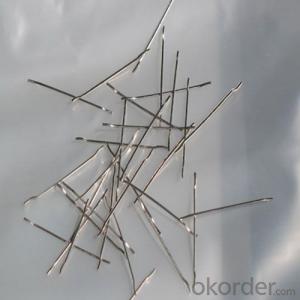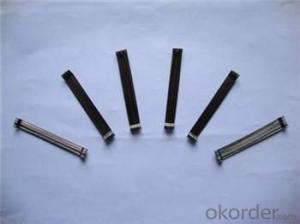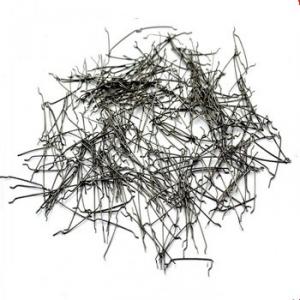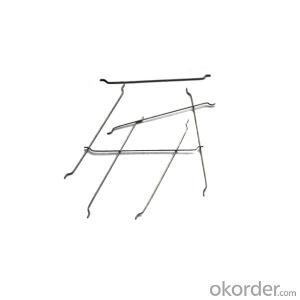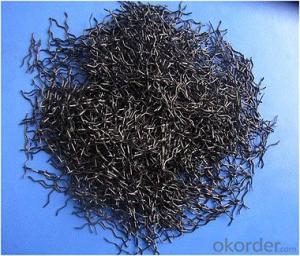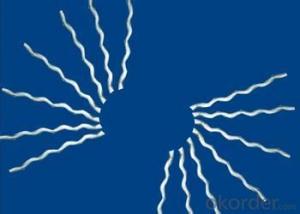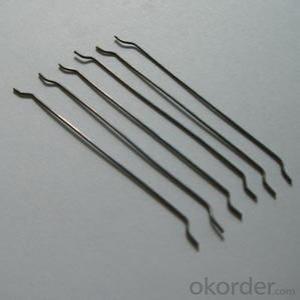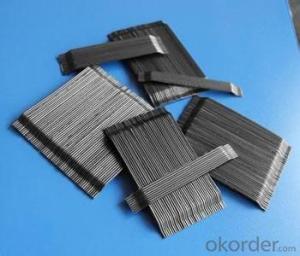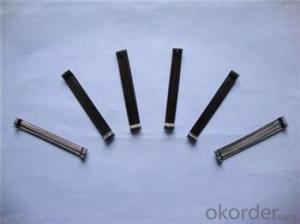Melt Extract Stainless Steel Fiber - Straight Type Copper Coated for Concrete
- Loading Port:
- Tianjin
- Payment Terms:
- TT OR LC
- Min Order Qty:
- 1000 kg
- Supply Capability:
- 30000 kg/month
OKorder Service Pledge
OKorder Financial Service
You Might Also Like
Quick Details
Place of Origin: China (Mainland)
Model Number: HT-ST
Material: Steel
The Products
Steel fiber for Concrete Reinforcement
High tensile strength 2.Length 6-60mm 3.Diameter 0.2-1.0mm
Specifications
Steel fiber for Concrete Reinforcement
1.High tensile strength
2.Length 6-60mm
3.Diameter 0.2-1.0mm
4.ISO9001, CE, TUV
Specification | Diameter (mm) | Length (mm) | Aspect ratio (L/D) | Tensile strength (Mpa) |
0.12/6 | 0.12 | 6 | 50 | 2500 |
0.2/6 | 0.2 | 6 | 30 | 2500 |
0.2/13 | 0.2 | 13 | 65 | 2500 |
0.3/25 | 0.3 | 25 | 83 | 2500 |
0.4/25 | 0.4 | 25 | 63 | 1200 |
0.4/30 | 0.4 | 30 | 75 | 1200 |
0.5/30 | 0.5 | 30 | 60 | 1100 |
0.5/25 | 0.5 | 25 | 50 | 1100 |
0.55/25 | 0.55 | 25 | 45 | 800 or 1000 |
0.6/30 | 0.6 | 30 | 50 | 1000 or 1100 |
0.7/30 | 0.7 | 30 | 43 | 1000 |
0.7/35 | 0.7 | 35 | 50 | 1000 |
0.75/35 | 0.75 | 35 | 47 | 1000 |
0.75/60 | 0.75 | 60 | 80 | 1000 |
0.8/60 | 0.8 | 60 | 75 | 1000 |
0.9/50 | 0.9 | 50 | 56 | 1000 |
0.9/60 | 0.9 | 60 | 67 | 1000 |
1.0/50 | 1.0 | 50 | 50 | 1000 |
1.0/60 | 1.0 | 60 | 60 | 1000 |
Picture
Steel fiber straight type
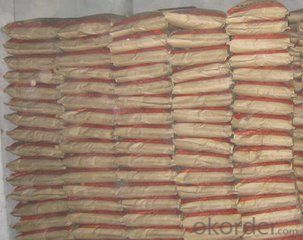
pp bag

any type steel fiber
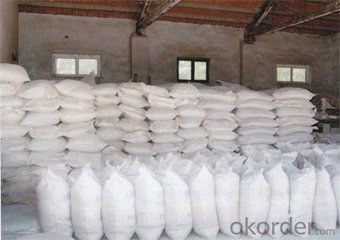
FAQ
certificated: ISO 9001
Technical advantages of Daye steel fiber:
A. Improve mechanical performance of concrete
B. Provide uniform distribution throughout concrete with excellent mixing
C. No balling or caking by adopt correct mixing method
D. Reduce concrete volume
- Q: What is the effect of melt extract stainless steel fiber on the water absorption of concrete?
- The effect of melt extract stainless steel fiber on the water absorption of concrete is that it significantly reduces the water absorption rate. The stainless steel fibers act as reinforcement within the concrete matrix, creating a more dense and impermeable structure. This reduces the porosity of the concrete and limits the penetration of water, ultimately improving the overall durability and resistance of the concrete to moisture-related damage.
- Q: Is melt extract stainless steel fiber suitable for use in architectural concrete?
- Yes, melt extract stainless steel fiber is suitable for use in architectural concrete. It provides enhanced durability, crack resistance, and improved structural integrity in concrete constructions. Additionally, it helps to reinforce the concrete, increasing its longevity and reducing maintenance costs.
- Q: Can melt extract stainless steel fiber be used in highway pavements?
- Yes, melt extract stainless steel fiber can be used in highway pavements. Stainless steel fibers are known for their high strength and durability, making them suitable for withstanding heavy traffic loads and harsh environmental conditions. When added to concrete or asphalt mixtures, stainless steel fibers enhance the overall performance of the pavement by improving its crack resistance, flexural strength, and fatigue resistance. This helps to extend the lifespan of the pavement and reduce the need for frequent repairs and maintenance. Additionally, the corrosion-resistant nature of stainless steel fibers ensures that the highway pavement remains intact and structurally sound over time. Therefore, the use of melt extract stainless steel fiber in highway pavements is a viable solution for enhancing their durability and longevity.
- Q: Can melt extract stainless steel fiber be used in airport pavement applications?
- Indeed, melt extract stainless steel fiber finds utility in the realm of airport pavement applications. Renowned for their exceptional tensile strength, resistance to corrosion, and capacity to augment the longevity and efficacy of concrete, these fibers prove instrumental in fortifying airport pavements against cracking, spalling, and fatigue induced by factors such as intense aircraft traffic, harsh weather conditions, and chemical exposure. Moreover, the inclusion of stainless steel fibers bolsters the structural integrity and lifespan of the pavement, rendering it an optimal selection for airports necessitating paramount performance and durability.
- Q: Are there any limitations or disadvantages of using melt extract stainless steel fiber?
- There are multiple limitations and disadvantages associated with the use of melt extract stainless steel fiber. To begin with, the cost of melt extract stainless steel fiber is high compared to other types of steel fibers. This can make it uneconomical for certain applications, especially for large-scale projects. Furthermore, the fiber length is generally short, which can restrict its effectiveness in reinforcing certain applications. Longer fibers are typically more successful in enhancing the tensile strength and crack resistance of concrete. Consequently, melt extract stainless steel fiber may not be suitable for applications that necessitate longer fiber lengths. In addition, the mixing process can present challenges when utilizing melt extract stainless steel fiber. Due to its short length and small diameter, the fibers tend to clump together during mixing, resulting in an uneven distribution within the concrete mix. This can lead to inconsistent reinforcement and reduced effectiveness. Another disadvantage is the potential for corrosion. While stainless steel is known for its resistance to corrosion, it is not completely immune. In certain aggressive environments, such as those with high chloride content or acidic conditions, the stainless steel fibers can corrode over time. This can result in degradation of the concrete's mechanical properties and reduced durability. Lastly, the use of melt extract stainless steel fiber may necessitate modifications to existing construction practices. Contractors may need to adjust their mix designs and concrete placement techniques to accommodate the addition of fibers. This can lead to increased complexity and potential delays in construction projects. In conclusion, while melt extract stainless steel fiber offers advantages in terms of improving concrete's mechanical properties, it also has limitations and disadvantages. These include high cost, short fiber length, challenges in mixing, potential corrosion, and adjustments to construction practices. Therefore, careful consideration of these factors is essential before deciding to incorporate melt extract stainless steel fiber into a construction project.
- Q: What is the recommended curing regime when using melt extract stainless steel fiber in concrete?
- When utilizing melt extract stainless steel fiber in concrete, it is generally advised to adhere to a curing regimen similar to regular concrete. This entails maintaining a consistent temperature and keeping the concrete moist for a specific duration to facilitate proper hydration and curing. To be more precise, it is typically recommended to follow the curing guidelines provided by the American Concrete Institute (ACI). These guidelines advocate for an initial period of moist curing lasting at least 7 days. During this time, the concrete should be kept moist by either continuous spraying or covering it with damp burlap, plastic sheeting, or similar materials. This practice serves to prevent moisture loss and promote optimal curing. Following the initial moist curing stage, it is advisable to continue the curing process for an additional minimum period of 14 days. This can be achieved by either maintaining moisture in the concrete or by employing a curing compound. Curing compounds are liquid coatings that are applied to the surface of the concrete, forming a protective barrier that prevents moisture loss. By creating this barrier, these compounds aid in retaining moisture within the concrete, thus facilitating proper curing. It is important to bear in mind that the specific curing regimen may differ depending on project requirements, environmental conditions, and the recommendations provided by the manufacturer of the melt extract stainless steel fiber used in the concrete. Therefore, it is always prudent to consult the manufacturer's technical data sheets or seek guidance from experienced professionals to ensure the correct curing regimen is followed for optimal performance of the concrete incorporating melt extract stainless steel fiber.
- Q: Can melt extract stainless steel fiber be used in lightweight concrete blocks or panels?
- Yes, melt extract stainless steel fiber can be used in lightweight concrete blocks or panels. Lightweight concrete blocks or panels are typically made by using lightweight aggregates and reducing the density of the concrete mixture. The addition of stainless steel fibers can enhance the mechanical properties of the lightweight concrete, such as increasing tensile and flexural strength, reducing cracking, and improving the overall durability of the blocks or panels. Stainless steel fibers have high tensile strength, corrosion resistance, and excellent bonding properties with concrete, making them ideal for reinforcing lightweight concrete structures. Additionally, the use of stainless steel fibers can also provide improved resistance to fire, impact, and fatigue. Therefore, melt extract stainless steel fiber is a suitable reinforcement option for lightweight concrete blocks or panels.
- Q: Can melt extract stainless steel fiber be used in architectural or decorative concrete?
- Indeed, architectural or decorative concrete can utilize melt extract stainless steel fiber. By incorporating stainless steel fibers, the strength and durability of the concrete can be enhanced, rendering it suitable for a multitude of applications within the construction sector. These fibers contribute to improved crack resistance, impact resistance, and overall performance of the concrete, thereby making it an optimal selection for architectural or decorative purposes. Moreover, stainless steel fibers possess the ability to bestow aesthetic advantages upon the concrete, notably by enhancing its appearance and texture.
- Q: How does melt extract stainless steel fiber improve the resistance to cracking in concrete?
- Melt extract stainless steel fiber improves the resistance to cracking in concrete due to its unique properties and characteristics. When added to concrete, these fibers act as reinforcement by providing additional tensile strength and ductility to the material. The stainless steel fibers are uniformly dispersed throughout the concrete matrix, creating a three-dimensional network that enhances the overall structural integrity. This network effectively distributes and absorbs stresses, preventing the formation and propagation of cracks. Moreover, the high aspect ratio of these fibers, combined with their strong bond with the concrete matrix, enhances the load-bearing capacity of the material. This means that when subjected to external forces or thermal changes, the stainless steel fibers act as micro-reinforcements, effectively resisting crack formation and reducing their width and length. Additionally, the corrosion resistance of stainless steel fibers is a significant advantage. Unlike other types of fibers, stainless steel does not corrode, even in harsh environments or when exposed to chemicals. This corrosion resistance ensures the long-term durability of the concrete structure and prevents the deterioration of its mechanical properties. Furthermore, the melt extract stainless steel fibers improve the resistance to cracking by reducing shrinkage and creep in concrete. Shrinkage occurs as the concrete dries and cures, and it often leads to cracking. The addition of stainless steel fibers reduces the overall shrinkage of the concrete, minimizing the potential for cracks to form. In summary, the inclusion of melt extract stainless steel fibers in concrete significantly improves its resistance to cracking. These fibers enhance the tensile strength, ductility, load-bearing capacity, and corrosion resistance of the material, providing a more durable and long-lasting concrete structure.
- Q: How does melt extract stainless steel fiber enhance the crack resistance of concrete?
- Melt extract stainless steel fiber enhances the crack resistance of concrete through several mechanisms. Firstly, the addition of stainless steel fibers to the concrete mix increases its tensile strength. This means that the concrete is better able to resist the forces that cause cracking, such as shrinkage, temperature changes, and external loads. The fibers help to distribute these forces more evenly throughout the concrete, reducing the likelihood of cracks forming. Secondly, stainless steel fibers act as reinforcement within the concrete matrix. When cracks do occur, the fibers help to hold the concrete together and prevent the cracks from propagating further. This improves the overall durability and longevity of the concrete structure. Furthermore, melt extract stainless steel fibers also enhance the impact resistance of concrete. The fibers absorb and distribute the energy from impacts, reducing the likelihood of cracks forming or propagating due to sudden loading. Additionally, stainless steel fibers can also improve the resistance of concrete to chemical attack. They provide a physical barrier that inhibits the penetration of aggressive chemicals, such as chlorides or sulfates, into the concrete. This helps to prevent the deterioration of the concrete and reduces the risk of cracks forming due to chemical exposure. Overall, melt extract stainless steel fiber enhances the crack resistance of concrete by improving its tensile strength, reinforcing the concrete matrix, increasing its impact resistance, and providing a barrier against chemical attack. These combined effects result in a more durable and crack-resistant concrete structure.
Send your message to us
Melt Extract Stainless Steel Fiber - Straight Type Copper Coated for Concrete
- Loading Port:
- Tianjin
- Payment Terms:
- TT OR LC
- Min Order Qty:
- 1000 kg
- Supply Capability:
- 30000 kg/month
OKorder Service Pledge
OKorder Financial Service
Similar products
Hot products
Hot Searches
Related keywords
